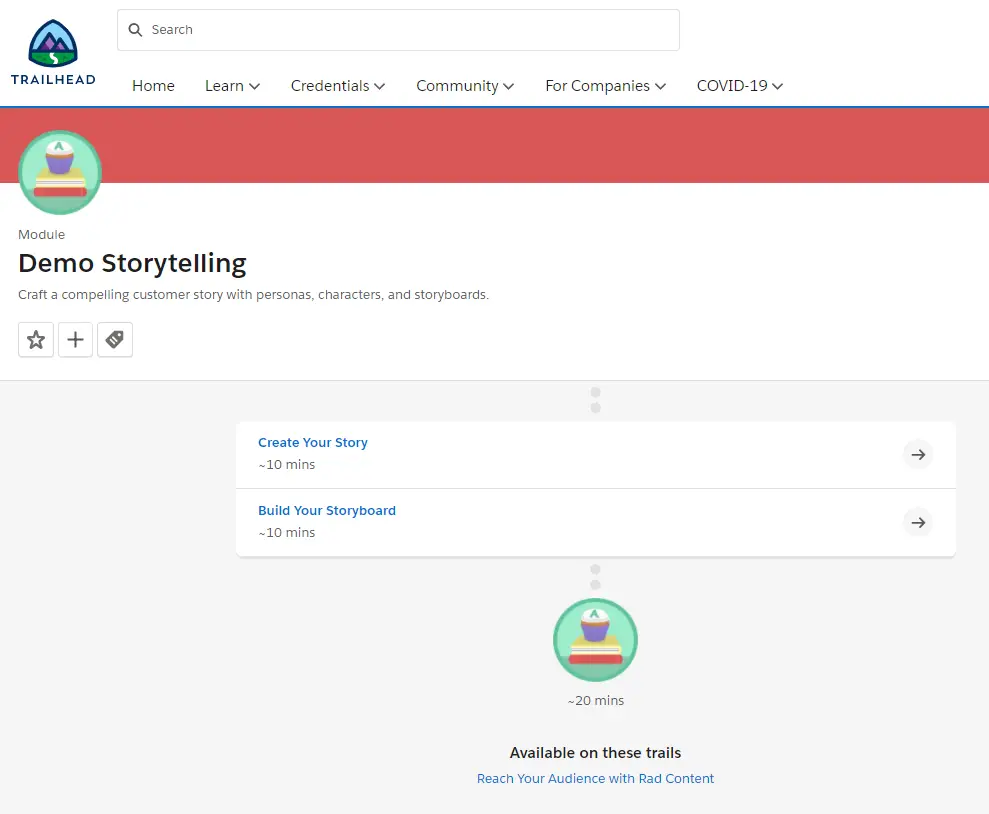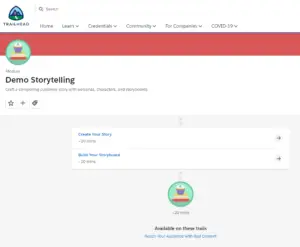In this article, we will see the answers, benefit, important & complete explanation of General Courses: Demo Storytelling -Trailhead Salesforce

#1.Create Your Story – Demo Storytelling
Q1)What is a benefit of telling a story during your demo?
I) Stories create emotional connections.
II) Stories take little time to create.
III) Stories are memorable.
IV) A and B
V) A and C
[bg_collapse view=”button-orange” color=”#4a4949″ expand_text=”Show Answers” collapse_text=”Close Answer” ]
V) A and C
[/bg_collapse]
Q2)What is a benefit of using a persona?
I) It represents your inner personality.
II) It creates a relatable connection with your customer.
III) It explains topics from your own viewpoint.
IV) It gets your talk track down.
[bg_collapse view=”button-orange” color=”#4a4949″ expand_text=”Show Answers” collapse_text=”Close Answer” ]
II) It creates a relatable connection with your customer.
[/bg_collapse]
Q3)Salesforce is the __ of your demo story.
I) Hero
II) Challenge
III) Helper
IV) Victory
[bg_collapse view=”button-orange” color=”#4a4949″ expand_text=”Show Answers” collapse_text=”Close Answer” ]
III) Helper
[/bg_collapse]
Q4)An effective helper statement for a customer interested in delivering exceptional customer service is:
I) LiveMessage helps you communicate better.
II) LiveMessage is the best customer service strategy.
III) LiveMessage eliminates the need for a web browser.
IV) LiveMessage lets agents send messages to customers instantly, reducing case resolution time.
[bg_collapse view=”button-orange” color=”#4a4949″ expand_text=”Show Answers” collapse_text=”Close Answer” ]
IV) LiveMessage lets agents send messages to customers instantly, reducing case resolution time.
[/bg_collapse]
#2.Build Your Storyboard
Q1)Why is it important to create a storyboard?
I) Storyboards are used during your demo.
II) Storyboards contain demo-ready slides.
III) Storyboards are used to organize thoughts.
IV) A and C
V) B and C
[bg_collapse view=”button-orange” color=”#4a4949″ expand_text=”Show Answers” collapse_text=”Close Answer” ]
III) Storyboards are used to organize thoughts.
[/bg_collapse]
Q2)What is the first step in outlining your storyboard?
I) Create your slides in Google Slides.
II) Draw your story on a whiteboard.
III) Build your demo.
IV) Lay out each device in chronological order.
[bg_collapse view=”button-orange” color=”#4a4949″ expand_text=”Show Answers” collapse_text=”Close Answer” ]
II) Draw your story on a whiteboard.
[/bg_collapse]
Q3)Use __ in your mockup Google Slides.
I) placeholders
II) screenshots
III) Google images
IV) videos
[bg_collapse view=”button-orange” color=”#4a4949″ expand_text=”Show Answers” collapse_text=”Close Answer” ]
I) placeholders
[/bg_collapse]
5 Things You Should Be Doing During Your Demo To Keep The Audience Engaged.
Being a sales guy all my life, I’ve had to learn how to sell myself and my company to customers. One of the ways I’ve always done this is through demos. Since I started my career as a software engineer, I would demo our product to potential clients in order to get them interested. As much as I hate giving presentations, my demos were always rock solid. The key was that I knew how to keep my audience engaged while I talked about our product or service. Here are some of the things you can do during your presentation to keep your audience focused:
The most important part of any presentation is the demo. It’s the moment when you really get to show off what your business has to offer and convince an audience that it’s possible for them to achieve great things too. At this point, a lot of entrepreneurs focus on getting the demo right. This means they spend a lot of time focusing on how great their product is and how it can help people. But what if there was more you could do during your demo to keep your audience engaged? Here are 5 things you should be doing during your demo:
3 Incredible Benefits Of Storytelling During Your Demo.
Storytelling is a great way to get people emotionally invested in your product, service, or brand. It’s one of the best ways to connect with your audience on a human level and inspire them to take action. During a demo, storytelling can be used to demonstrate how your business works, get more people excited about what you offer, and help people visualize themselves using your product.
Storytelling is probably one of the most powerful ways to get people to understand what your product or service does. When you combine storytelling with a demo of your product, there are 3 amazing benefits that happen:
People think that sales are about pitching. It’s about storytelling. Sales are about leading people through a series of events. It’s about creating a narrative. Companies with great stories sell more products, generate more leads and grow faster than their competitors. That’s because people love stories. They’re the most powerful way to convey your message to your prospects. If you look at the most successful companies in the world, they all share one thing in common – they have a great story to tell.
A demo is a sales pitch that aims to persuade someone to buy a product or service. But is it possible to make your demo more interesting, by telling a story? #1 – Storytelling builds rapport People love stories. Telling a story in a demo can make the listener feel like they’re having a conversation with you. When you have this kind of connection, your customer will be more likely to trust you and learn from what you have to say.
Being a sales guy all my life, I’ve had to learn how to sell myself and my company to customers. One of the ways I’ve always done this is through demos. Since I started my career as a software engineer, I would demo our product to potential clients in order to get them interested. As much as I hate giving presentations, my demos were always rock solid. The key was that I knew how to keep my audience engaged while I talked about our product or service. Here are some of the things you can do during your presentation to keep your audience focused:
why do storytelling is important?
The power of a great story can be used to condition, motivate and persuade others. People remember stories, they don’t remember facts. What is the definition of a story? It is an account of connected events describing real or imaginary people and happenings. You will learn how to use storytelling techniques to turn your business into an incredible success.
When it comes to content marketing, you have to tell stories. Your audience wants to hear them, and they’re a great medium for promoting your brand. Here’s how you can start using storytelling to promote your brand online. Start With The Right Story Do your research and make sure the story you want to share is relevant. It has to be one that people want to hear, but also one that fits in with your brand. You should also tailor the story for each platform you share it on. For example, if you post it on Instagram, include images as much as possible.
How To Tell A Story During Your Demo: The 4 Tips.
You’ve been asked to present your product in a demo. You’re excited. You think you have a great idea and a great solution to the problem you’re solving. But then, you start talking, telling your story… and nothing happens. Your audience is not engaged with your story. They don’t ask questions or share their opinions. Instead, they are just listening to what you say, even though it’s interesting and valuable for them.
Whether your company is just starting out or you’re looking to grow quickly, you need to be able to tell stories that move your audience and ultimately convince them to buy. That’s why every successful salesperson knows how to tell a story in their demo. When it comes to developing an effective demo, the phrase “show, don’t tell” is particularly important. The best salespeople know how to use storytelling techniques to captivate their audience, by telling the story of the challenges their clients faced, the problems they were having, and how their product or service was solved.
A well-told story can keep your readers engaged, as well as provide an opportunity to use your own content in interesting new ways. Here are 4 tips to help you tell stories that will draw people in and get them hooked on your content.
1. Make it personal. The best stories are rooted in real-life experiences, and we all love to hear a good tale. Make sure the story you choose has a clear narrative and plenty of action.
2. Be descriptive and descriptive. Tell us exactly what you saw with your own eyes, what you felt, smelled, heard, tasted; make us
3. Tell it in the first person. This will make your audience believe that you are right there beside them, and they’ll be able to relate to your story better this way.
4. Think about your target audience – All good story
List Of Trailhead Salesforce Modules:
- Module: Big Object Basics -Salesforce Answers
- Module: Event Monitoring -Salesforce Answers
- Module: Platform Cache Basics -Salesforce Answers
- Module: Org Development Model -Salesforce Answers
- Module: Change Set Development Model -Salesforce Answers
- Module: Application Lifecycle And Development Models -Salesforce Answers
- Module: Platform Events Basics -Salesforce Answers
- Module: Asynchronous Apex In Salesforce (Answers)
- Module: User Interface API Salesforce Answers
- Module: Quick Start: Lightning Web Components (Answers)
